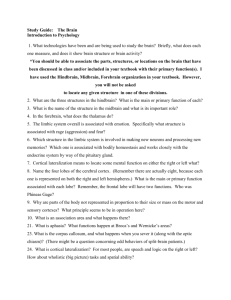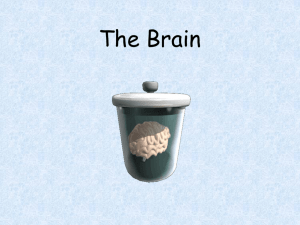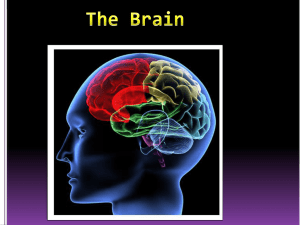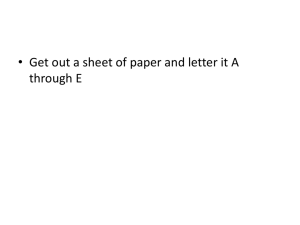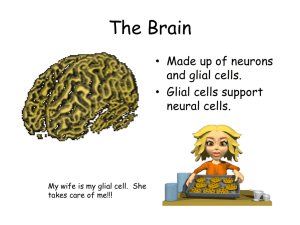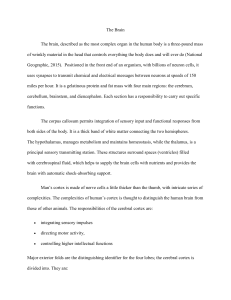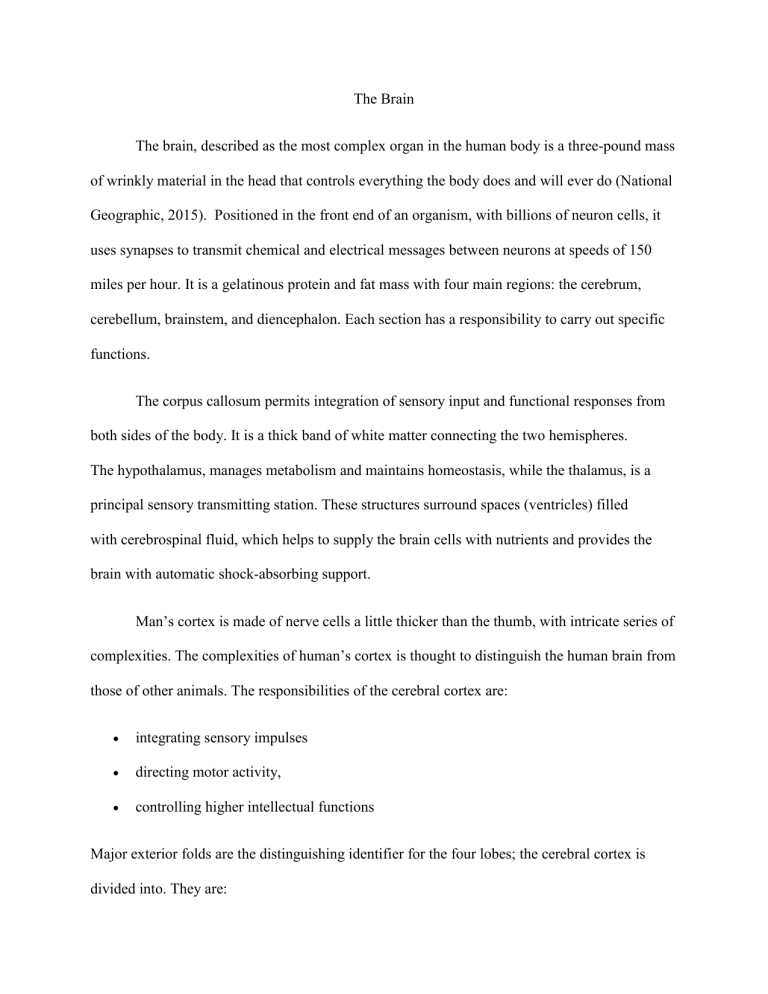
The Brain The brain, described as the most complex organ in the human body is a three-pound mass of wrinkly material in the head that controls everything the body does and will ever do (National Geographic, 2015). Positioned in the front end of an organism, with billions of neuron cells, it uses synapses to transmit chemical and electrical messages between neurons at speeds of 150 miles per hour. It is a gelatinous protein and fat mass with four main regions: the cerebrum, cerebellum, brainstem, and diencephalon. Each section has a responsibility to carry out specific functions. The corpus callosum permits integration of sensory input and functional responses from both sides of the body. It is a thick band of white matter connecting the two hemispheres. The hypothalamus, manages metabolism and maintains homeostasis, while the thalamus, is a principal sensory transmitting station. These structures surround spaces (ventricles) filled with cerebrospinal fluid, which helps to supply the brain cells with nutrients and provides the brain with automatic shock-absorbing support. Man’s cortex is made of nerve cells a little thicker than the thumb, with intricate series of complexities. The complexities of human’s cortex is thought to distinguish the human brain from those of other animals. The responsibilities of the cerebral cortex are: integrating sensory impulses directing motor activity, controlling higher intellectual functions Major exterior folds are the distinguishing identifier for the four lobes; the cerebral cortex is divided into. They are: The frontal lobes - contains control centers for problem solving, judgment, speech and motor function. The parietal lobes - manage sensation (somatic senses-touch and position), handwriting, and body position. The temporal lobes - involved with memory and hearing. The occipital lobes - containing the brain's visual processing system (Hoffman, MD. 2021) Sometimes the limbic lobe, involved with smell, taste, and emotions, is considered a fifth lobe. The cerebrum also called the forebrain, located inside the forehead, is the largest uppermost part of the brain accounting for 85% of the brain’s weight; it controls the body’s higher functions such as language, reasoning, and speech. The outer deeply wrinkled layer-grey matter is the cerebral cortex. The inner core consist of myelinated nerve fibres, called white matter. The olfactory and optic cranial nerves, the lateral and third cerebral ventricles are found in the forebrain. The cerebrum is divided into two halves called the cerebral hemispheres, which appears identical. The left hemisphere however, is usually more dominant functionally, managing language and speech while the other is responsible for visual and spatial information. The right hemisphere is considered our creative side, and the left hemisphere is considered our logical side. It is responsible for: - Reasoning - Organizing - Planning - facial expressions -serial task -problem solve - spontaneity - initiation of self-regulatory behaviors -Speaking - moving - inhibition control -focus -memory - emotions control At the upper rear of our brain is the parietal lobe that regulates our complex behaviors It plays important roles in, such as -vision - touch - body awareness - spatial orientation - integrating sensory information from various parts of our body - number knowledge and mathematics functions - language comprehension - neglect/inattention - aids visuospatial processing - body positioning and movement - differentiation of left-right -self-awareness/insight. At the back of our brain is the occipital lobe associated with our visual processing such as: - visual recognition -visual attention -visual perception of body language -spatial analysis (moving in a 3-D world) The temporal lobe, located near our ears, is associated with: Processing our perception and recognition of auditory stimuli (including our ability to focus on one sound among many, like listening to one voice among many at a party)comprehending spoken language verbal memory, visual memory and language production (including fluency and word-finding) general knowledge autobiographical memories References Britannica, T. Editors of Encyclopaedia (2020, March 21). brain. Encyclopedia Britannica. https://www.britannica.com/science/brain Britannica, T. Editors of Encyclopaedia (2020, February 5). Forebrain. Encyclopedia Britannica. https://www.britannica.com/science/forebrain Zuckerman, C. (2009, October 15). Brain 101. National Geographic. https://www.nationalgeographic.com/science/article/brain-2 Hoffman, M. (2021, June 23). Picture of the brain. WebMD. https://www.webmd.com/brain/picture-of-the-brain The brain The brain is a complex organ that acts as the control center of the body. As a part of the central nervous system, it is responsible for sending, receiving, processing, and directing sensory information. The corpus callosum, a fibrous band, divides the brain into left and right hemispheres, under these are the diencephalon, which contains the thalamus, hypothalamus, epithalamus, and subthalamus The brain has three major divisions: forebrain (or prosencephalon), midbrain (mesencephalon), and hindbrain (rhombencephalon), each is responsible for performing specific functions. The largest part of the brain is the forebrain with the cerebrum, just inside the forehead, it is the largest uppermost part of the brain accounting for 85% of the brain’s weight and covers most other brain structures. The two subdivisions of the forebrain are the telencephalon and diencephalon. The olfactory and optic cranial nerves are found in the forebrain, including the lateral and third cerebral ventricles. Telencephalon-The Forebrain The telencephalon is divided into four lobes, the frontal lobes, parietal lobes, occipital lobes, and temporal lobes. The cerebral cortex is a major component of the telencephalon. The folded bulges of the cerebral cortex are called gyri; they create indentations in the brain. Functions of the cerebral cortex include processing sensory information, controlling motor functions, and performing higher-order functions such as reasoning and problem-solving. The functions of the lobes are as follows: Frontal Lobes: The prefrontal cortex, premotor area, and motor area of the brain. These lobes function in voluntary muscle movement, memory, thinking, decision-making, and planning. Parietal Lobes: Responsible for receiving and processing sensory information. These lobes also contain the somatosensory cortex, which is essential for processing touch sensations. Occipital Lobes: Responsible for receiving and processing visual information from the retina. Temporal Lobes: Home of the limbic system structures, including the amygdala and hippocampus. These lobes organize sensory input and aid in auditory perception, memory formation, and language and speech production. Diencephalon The sensory information and apparatuses links of the endocrine system is communicated to the nervous system via the diencephalon. It controls a number of functions including autonomic, endocrine, and motor functions. It is important for sensory awareness. The diencephalon comprises: Thalamus Areas of the cerebral cortex that are involved in sensory perception and movement are connected by this limbic system structure with other parts of the brain and spinal cord. The control of sleep and wake cycles are also influenced by the thalamus. Hypothalamus Many autonomic functions such as respiration, blood pressure, and body temperature regulation are managed by the hypothalamus. A hormone secreting endocrine structure controlling biological processes by action on the pituitary gland. It control biological processes like metabolism, growth, and the development of reproductive system organs. The hypothalamus is the element of the limbic system influencing various emotional responses through its influence on the pituitary gland, skeletal muscular system, and autonomic nervous system. Pineal Gland This small endocrine gland produces the hormone melatonin. Which is a hormone that affects sexual development and is necessary for the regulation of sleep-wake cycles. Signals from the sympathetic component of the peripheral nervous system is transformed by the pineal gland into nerve hormone signals, which links the nervous and endocrine systems. The Midbrain The midbrain connects the forebrain to the hindbrain and the midbrain with hindbrain compose the brainstem, which connects the spinal cord with the cerebrum. The midbrain aids in the processing of aural and optical information and normalizes movement. The oculomotor and trochlear cranial nerves that control eye and eyelid movement are located in the midbrain. A tube linking the third and fourth cerebral ventricles called the cerebral aqueduct, is in the midbrain. The midbrain also comprises: Tectum The superior and inferior colliculi are the hind part of the midbrain. These are rounded humps are impacts visual and auditory reflexes. The superior colliculus handles the interpretation and transition of visual signals to the occipital lobes while the inferior colliculus processes auditory signals and dispatch them to the auditory cortex in the temporal lobe. Cerebral peduncle There are large bundles of nerve fiber tracts connecting the forebrain to the hindbrain at the front of the midbrain. In the midbrain, is the tegmentum with reticular formation and the red nucleus. The reticular formation is a bundle of nerves within the brainstem sending sensory and motor signals to and from the spinal cord and the brain. It aids in the control of autonomic and endocrine functions, as well as muscle reflexes and sleep and awake states. The red nucleus is a mass of cells that aids in motor function. Substantia nigra: aiding in control of voluntary movement and regulating mood is a large mass of brain matter. The substantia nigra has pigmented nerve cells and produces dopamine which is a neurotransmitter. The Hindbrain The two sub regions of the hindbrain are the metencephalon and myelencephalon; there are many cranial nerves in this section of the brain. The hindbrain supports the regulation of involuntary functions, maintaining balance and equilibrium, movement coordination, and the relay of sensory information. Metencephalon The metencephalon is the upper region of the hindbrain and contains the pons and cerebellum. The pons is a component of the brainstem, which acts as a bridge connecting the cerebrum with the medulla oblongata and cerebellum. The pons assists in the control of autonomic functions, as well as states of sleep and arousal. The cerebellum relays information between muscles and areas of the cerebral cortex that are involved in motor control. This hindbrain structure aids in fine movement coordination, balance and equilibrium maintenance, and muscle tone. Myelencephalon In the lower region of the hindbrain, below the metencephalon and above the spinal cord is the myelencephalon where the medulla oblongata is located. Motor and sensory signals between the spinal cord and higher brain regions are communicated by this portion of the brain it also aids in the regulation of autonomic operations such as breathing, heart rate, and reflex actions including swallowing and sneezing. While all parts of the brain are important and play a vital role in every activity, it is clear that the forebrain is the region that is responsible for learning. Any damaged to the frontal lobe or areas of the frontal lobe, affect learning. The severity of the impact will depend on the severity of the damage experienced. References Bailey, R. (2019, November 15). Divisions of the Brain: Forebrain, Midbrain, Hindbrain. ThoughtCo. https://www.thoughtco.com/divisions-of-the-brain-4032899 Britannica, T. Editors of Encyclopaedia (2020, February 5). Forebrain. Encyclopedia Britannica. https://www.britannica.com/science/forebrain

